
Job Johnson (Job Clifford Johnson)
(1860-1937)
Born: Pine Station, Pennsylvania
Worked: McElhattan, Pennsylvania
North Central Pennsylvania folk artist Job Johnson presents modern audiences with a distinctive commentary on frontier life in the late 19th and early 20th centuries.
Born and raised on a tobacco farm with the prospect of a life of toil, it appeared impossible (or at least impractical) for Johnson to pursue his desire to create art. Spurred on by his good friend and renowned local writer, Col. Henry Shoemaker, Johnson began his artistic endeavors at the not-so-tender age of 38. Both men shared an interest in local folklore and also in the belief that art – in all its manifestations- can draw attention to issues of environmentalism and conservation. Johnson explores this theme in his work “The Last Great Pine,” in which a solitary white pine tree stands alone in a forest devastated by the Pennsylvania logging industry of the late 1800s. Shoemaker’s monument to the Native American tribe Lenni Lenape also became a subject of Johnson’s work, signifying the remnants of a civilization lost as a direct result of the destruction of the area’s natural landscape.
Johnson’s works are not only visual attestations of people and period, but also of his childhood. “The Stripping Room,” shows settlers in the Pennsylvania-wild living free of the technology that would soon advance upon the community, changing its way of life forever.
With over 1,000 works attributed to the artist, Johnson’s prolificacy is reflected in his variety of interests; folklore is one of his many subjects. “Devil’s Cave,” illustrates a nontraditional Satan with three eyes holding out a book for the viewer to sign. One of Johnson’s drawings with color, he used clay to create the reddish glow emanating from the Devil’s book, making it leap from the charcoal background. His illustration of Lucifer is unconventional; it’s moral is Hawthornian – a life of honest hard work is superior to one of corruption.
While the Industrial Revolution generated an entirely new process – mass production – each of Job Johnson’s works is a unique artifact, from handcrafted paper to the frames he fashioned from branches collected outside his McElhattan home. His work, although inspired by the son of a wealthy Industrialist (Shoemaker) is an ironic affront to that same system.
Johnson remained a hermit living in a small, double room shack on several acres of family land until his death at the age of 77. He surrounded himself with his work – his home and shed were covered from floor to ceiling with his art. They became the property of his brother’s widowed wife, Lottie Mae Johnson and have been passed down through the Johnson family of Lycoming and Clinton counties. Issues that Johnson tackles in his works – dealing with conservation, environmentalism, and technology – are still contemporary. Johnson’s images are an echo of concern in the endless chasm of what he saw as the modern world’s affront to tradition – his work will remain significant as long as these conflicts continue to be common issues through the generations.





